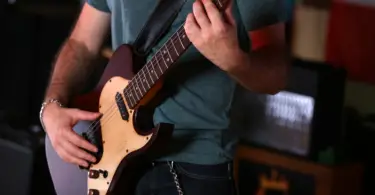Many people appreciate listening to or playing acoustic versions of songs. It’s a one-of-a-kind experience that’s nothing like listening to a full band version. Hearing a piece in this acoustic format has a beautiful and distinct quality to it.
How do you change acoustic guitar strings? Changing acoustic guitar strings is easy. First, find a workplace. Then, remove the old strings, and place the new ones. But of course, tuning will be part of these steps to ensure that the new string plays well.
It’s easier than you think to restring your acoustic guitar. In this session, I’ll walk you through the entire process of changing your acoustic guitar strings.
Quick Links
How To Change Acoustic Guitar Strings
Changing the strings on an electric or acoustic guitar isn’t difficult, but try convincing a beginner guitarist of that. To a newcomer, it might be pretty intimidating.
Learning how to change your strings is an important skill to have as a guitarist. Guitar strings have a habit of snapping at inconvenient times, such as during a concert.
It’s vital to know how to fix a damaged string at the moment. However, a broken string isn’t the sole reason to replace them.
While vintage guitars get better with age, old strings don’t. A build-up of dirt, sweat, dead skin, and oils found naturally in the fingers affects guitar strings’ age, tone, and intonation.
Strings grow dull, are challenging to play, and are prone to breakage as they age. You can fix it with a new set of strings. The tone of the new strings is brighter. They are easy on the fingers and remain in tune better.

Things You Will Need
- A guitar
- New strings
- Wire cutters
- String winder
- Neck Support
- Soft cloth
Steps To Follow
1. Find A Workspace
The operation will be much easier if you have a clean desk or table to place the guitar on during the string replacement.
- To avoid scratching the back of the guitar, you can lay a towel down.
- You’ll also need something to support the guitar’s neck. You can either buy a device designed for this purpose or make do with a stack of books or anything equivalent in height.
2. Remove Strings
We have to make a choice here. Will you restring the guitar one string at a time rather than removing everything at once? Or will you remove all of the strings at once and then replace them with fresh ones?
Some prefer to change them one by one. Most artists like their guitar setup, and they have a strange habit of removing all of the neck tension. These artists are afraid that after they finish, the action will be different. It seems implausible, but that’s just an opinion.
If your guitar is dirty, you’ll want to remove all the strings at once. This will allow you to clean it thoroughly.
Tip #1: The old strings should not be severed. You can unwind them slowly and save the previous set in the case as a backup. You can loosen the guitar strings and then clip them if you already have a replacement set. It is way easier to do it this way since getting the string off the peg is much easier.
Tip #2: A bridge pin secures each string in place. You can remove this by using a string winder’s little slot. You can also gently push them up by sticking your palm into the soundhole.
3. Put On The New Strings
Bridge Side
- The first step in installing a new string is to seat the string’s ball end beneath the bridge pin. The ball end of the string is the tiny spherical bit of metal at one end. Some would prefer to slide the string into the hole first, then lightly insert the peg approximately 3/4 of the way through.
- Then draw upon the string until the ball end of the string touches the bridge pin.
- After that, gently pull the cord and push the pin in.
- Before starting to wind the string, give it a little test pressure by drawing it towards the guitar’s headstock to ensure it’s seated and secure.
Tuner Side
When replacing strings, this is where the majority of individuals make mistakes. There are a few essential details to pay attention to.
- To begin, make sure you leave enough slack in the string so that it can wind around the peg and stay put. How much is it? Approximately two inches. The amount of distance between the current tuning post and the next tuning post can be helpful.
- The direction in which the strings are coiled is the next item that folks get wrong. Wind them to the middle. This prevents them from interfering with one another.
- Finally, we’re onto the first and second strings. It is be best if you wrap the string in such a way that it clamps down on itself and does not slip as you bring it up to pitch.
- Insert the string through the tuning peg hole, give it the appropriate amount of slack, and press it up and around the peg towards the center. The key is to ensure that the wrap extends above the hole, with the excess string protruding.
- Start winding the thread from here, ensuring that each wrap goes beneath the hole with the excess string. This method prevents the string from sliding.
- You should see a single wrap above the hole, an excess string, and all other wraps below that.
4. Tune The Guitar
You might have trouble keeping the strings in tune once you’ve changed all of them.
- After you’ve installed the strings, stretch them to fix the problem.
- Pull the string from the spot at the end of the neck to achieve this.
- Before tuning, give each string a good tug, and then do it again after tuning.
Yes, it will re-tune the guitar, so re-tune after stretching the strings and then begin the tugging process all over again. Repeat this method four to six times until the strings do not go out of tune when tugged.
5. Trim The Strings
- Cut the extra string as near the peg as possible with the wire cutters to trim the strings.
- Keep an eye out to ensure you don’t unintentionally clip the tensioned string instead of the extra piece.
6. Play A G Chord
It would be best to do what 9 out of 10 guitarists do after being tuned and ready to play. You strum a G chord and enjoy the new strings’ bright, sharp tone.
Things To Know Before Changing Your Guitar Strings
Get Your Gauge Right
Strings are available in a range of gauges and can be purchased separately or in sets. The thickness of a guitar string is measured in thousandths of an inch. But this is commonly referred to as string gauge.
The heavier the string, the larger the gauge. Guitarists usually leave off the decimal and talk about the number when describing gauges. For example, a string gauge of.008 is referred to as an 8.
A set of 0.009s is regarded as extremely light, but a set of 0.014s is quite heavy. The gauge string you select is a personal choice that depends on your playing style and the tone you want to achieve. Both lighter and heavier gauges have advantages and disadvantages.
The easier it is to bend the guitar string, the lighter the string gauge. Lighter gauge strings are easier to press down, but they are more challenging to stay tuned and have a softer tone. Lighter gauges are simpler to play. However, they’re more prone to breaking and result in more fretboard buzzing when the neck movement is low.
Strings with a heavier gauge are harder to push down. But, they work better in detuned conditions, such as drop D tuning. Strings with a larger gauge provide additional volume and sustain. They also produce a louder sound.

When To Change Your Strings
Some people say they change strings every 2-3 weeks. But others say they change them every 2-3 months. The rest say they only change strings when they break one.
The truth is that it’s very dependent on many external circumstances. It’s possible that the question of “how often” isn’t the most useful one to ask. “Why should I change my guitar strings in the first place?” is arguably a more helpful question.
We’ll discover that this offers us a better sense of the ‘when.’ In general, there are three main advantages to buying fresh guitar strings:
Tone
The most noticeable distinction is in the ‘tone.’ New strings will sound much brighter and more lively than old strings. It is because worn strings corrode from continual touch with your skin and through ordinary wear and tear against the guitar frets. These elements impact how the strings resonate and sustain, which, in turn, affect how they sound.
Tuning
Second, these same irregularities pile up and develop when we play. This can cause aged strings to have more trouble with intonation and keeping in tune. If the way your strings vibrate changes as they decay, it stands to reason that their tuning will alter as well.
Reliability
Finally, for the same reasons as previously explained, old strings are more prone to breaking. The more wear and tear we put on a guitar string, the less durable it becomes.
New strings will allow us to obtain more from our tone, perform better in tune, and be less prone to break. So, what does this tell us about when it’s time to replace our strings? Well, here are a few prominent examples:
- When we do any recording, we want to make sure that our guitar sounds as good as possible. New strings are the simplest and most cost-effective technique to improve performances.
- Every time our guitar is “set up,” we should use a new string. This will provide precise tuning and intonation changes.
- When we have a big performance, we usually put on a new set of strings to reduce the chances of strings breaking.
These are only a few general ideas. Someone who performs frequently or does many studio sessions might want to change their strings several times a week. However, someone who rarely plays with their guitar would only need to change strings less frequently.
It all comes down to personal preference. In any scenario, understanding “why” we could consider modifying strings will aid us in making an informed decision about “when” to do so.
Finally, use your common sense. Remember to always play with clean hands and wipe the strings down using a clean cloth. These methods will help you get more life and tone out of the strings.
Importance Of Changing Your Guitar Strings And Guitar Maintenance
Guitar care is one of the most vital aspects of guitar ownership, yet it’s also most neglected. No matter how cheap or expensive, a well-maintained guitar will offer you the best possible performance.
Lack of upkeep, on the other hand, might drastically limit what that instrument can offer. Many guitar players are unaware of how complicated this instrument truly is.
Any guitar is only as excellent as the sum and state of its parts. The entire concept falls apart if one element is out of rhythm.
This is why, as soon as you get a guitar, you should become comfortable with changing the strings as needed. You should also provide general guitar maintenance and care. You’ll not only get the best performance out of your instrument, but you’ll also extend its lifespan.
Here are few ways to maintain your guitar:
- Clean the Body & Strings – When you’re changing the strings on your guitar, it’s the greatest time to clean it. You’ll have complete access to the bridge and fretboard this way. In most cases, all that is required is a damp microfiber cloth and a little elbow grease.
- Maintain Proper Humidity – It is easy to maintain the humidity of your acoustic guitar. You can buy guitar humidifiers.
- Condition Your Fingerboard – Cleaning and conditioning the fingerboard keeps it clean. It will also ensure the greatest possible performance condition. Cleaning a fretboard using #0000 steel wool, often known as “super fine steel wool,” is the most common method.
Conclusion
Some guitar players are so intimidated to change their guitar strings that they never learn to do it themselves. So, they rely on their local guitar shop to do it for them. Meanwhile, others are utterly unaware that they need a replacement. If you have finished reading the entire post, changing your guitar strings is now easier for you.







